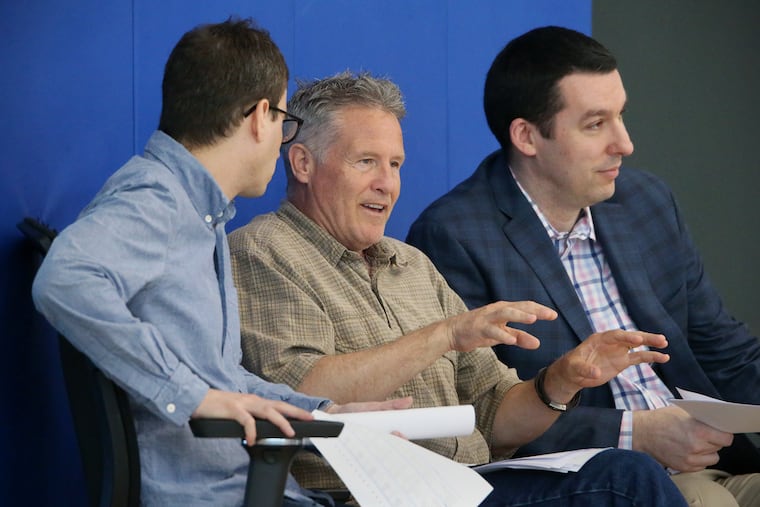Sixers have a lot of work to do that doesn’t involve replacing a coach
Multiple league sources don’t expect executive vice president of basketball operations Alex Rucker — who's been heavily involved in a lot of behind-the-scenes decisions — to be back next season.

The 76ers are in need of much more than a coach.
One can argue that hiring “basketball people” to help run the front office is a bigger priority. As a result, don’t be surprised if the Sixers address that before replacing fired head coach Brett Brown.
That’s the way things traditionally work in the NBA.
The biggest question is how much power the Sixers ownership will relinquish. Will CEO Scott O’Neil have a say? Will general manager Elton Brand truly be the main decision-maker? Or will the team hire an outsider to help Brand make hard decisions, or entrust that person to make them?
The one thing we do know is the Sixers relied too heavily on analytics during The Process and failed to live up to their lofty expectations. The team dismissed Brown on Aug. 24, one day after being swept by the Boston Celtics in the first round of the playoffs. Brown struggled with late-game situations and with holding players accountable. (Los Angeles Clippers coach Ty Lue remains the front-runner to replace him.)
However, you can’t blame Brown for the team’s reliance on analytics to make questionable draft picks, trades, and free-agent signees, which have set the franchise back.
Multiple league sources don’t expect executive vice president of basketball operations Alex Rucker to be back next season. Brand has received a lot of criticism for the Sixers’ shortcomings and poor decisions. However, Rucker has been heavily involved behind the scenes in a lot of the decision-making, according to sources. Philly originally hired him as VP of analytics and strategy in October 2016 after seven years as the Toronto Raptors' senior analytics consultant.
Sources have said assistant GM Ned Cohen and VP of strategy Sergi Oliva were also involved in the decision-making. Oliva had a lot to do with determining the Sixers’ rotation and substitution patterns based on the analytics, according to sources. He was an integral part of the coaching meetings and presented the coaches with an analytics sheet to consult during games.
Time will tell who the Sixers opt to let go, or if they will re-assign Cohen, Oliva or others in their front office. But a change is definitely coming.
“As I’ve been taking a deep dive in where we failed, what went wrong, and how we can get better, I felt like we need to strengthen our organization from top to bottom,” Brand said last month, “and that starts with the front office.”
He was specific about balancing the Sixers' strengths, analytics, and basketball strategy.
“My goal, with whatever happens going forward,” Brand said, “is making sure we are in position to truly contend.”
But the heavy reliance on analytics and poor roster decisions that were made definitely dampened what a year ago appeared to be a promising future.
The Sixers opted to go big in an era when most teams are going with smaller lineups and the center position is being devalued.
In addition to having spacing issues associated with their towering lineup, the Sixers find themselves in a huge financial bind.
So far, the Sixers could have $147 million tied up in 11 players next season with the bulk of the money going to Tobias Harris ($34.3 million), Joel Embiid ($29.5 million), Ben Simmons ($28.75 million), and Al Horford ($27.5 million).
The problem is the league’s salary cap could remain at its current $109.1 million ordrop because of lost revenue due to the coronavirus pandemic. The same can be said of this season’s luxury-tax threshold of $132.6 million.
As a result, the Sixers ownership group is expected to pay a luxury tax on a team not expected to finish higher than seventh in the Eastern Conference next season. Just with those 11 players, they are projected to pay $13.7 million in luxury tax. Their tax fee will increase because the Sixers will need to fill at least three more roster spots.
And that’s just the beginning. The Sixers have more than $480 million guaranteed tied up for the next five seasons in Harris, Embiid, Simmons, and Horford.
The Sixers could try to offer their first-round pick (No. 21) along with Horford’s salary (three years and $81 million remaining, with $69 million guaranteed) in a trade to get some type of flexibility. But at 34, Horford could be tough to move.
They might also have a tough time moving the remaining $147.3 million over four years on Harris’ contract.
So the Sixers have a lot of tough decisions to make that don’t involve a coaching search.